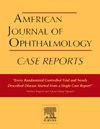Successful treatment of bilateral familial iris flocculi associated with aortic valve abnormalities
Q3 Medicine
引用次数: 0
Abstract
Purpose
To report a case of familial iris flocculi in siblings associated with a possibly life-threatening aortic valve manifestation due to a smooth muscle alpha-actin 2 (ACTA2) gene variant and demonstrate successful treatment of iris flocculi with laser.
Observations
Two biological siblings, a 21-year-old male and a 24-year-old female, both presented with bilateral iris flocculi. The flocculi were causing visual disturbances for both patients. Treatment was provided in the form of yttrium aluminum garnet (YAG) laser to the cysts and remained stable at 2 year follow up. Cardiac investigations were launched and the female patient demonstrated a bicuspid aortic valve with a mildly dilated ascending aorta. Cardiac investigations for the male patient were normal. Gene sequencing revealed a pathogenic variant in the ACTA2 gene.
Conclusions and importance
Bilateral iris flocculi is a rare ocular condition that can demonstrate a familial component. Treatment of the cysts is required only when there are visual symptoms. We demonstrate successful long term treatment using Nd: YAG laser. There is a link between iris flocculi and a variant of ACTA2 and/or the smooth muscle (MYH11) genes. Patients with iris flocculi should have careful cardiac assessment looking for aortic anomalies as well as gene sequencing. Family members should be made aware and investigated.
双侧家族性虹膜絮凝伴主动脉瓣异常的成功治疗
目的报告1例家族性虹膜絮凝与平滑肌α -肌动蛋白2 (ACTA2)基因变异引起的可能危及生命的主动脉瓣表现,并证明激光成功治疗虹膜絮凝。2例亲兄弟姐妹,1男21岁,1女24岁,均出现双侧虹膜絮凝。这两个病人的视力都受到了影响。以钇铝石榴石(YAG)激光的形式对囊肿进行治疗,并在2年的随访中保持稳定。心脏检查启动,女性患者表现出二尖瓣主动脉瓣和轻度扩张的升主动脉。男性患者心脏检查正常。基因测序显示ACTA2基因存在致病性变异。结论及重要性双侧虹膜絮凝是一种罕见的具有家族性的眼部疾病。只有在出现视觉症状时才需要治疗囊肿。我们展示了Nd: YAG激光成功的长期治疗。鸢尾絮状花序与ACTA2和/或平滑肌(MYH11)基因的变异之间存在联系。患有虹膜絮凝的患者应仔细检查心脏,寻找主动脉异常并进行基因测序。应该让家庭成员知道并进行调查。
本文章由计算机程序翻译,如有差异,请以英文原文为准。
求助全文
约1分钟内获得全文
求助全文
来源期刊

American Journal of Ophthalmology Case Reports
Medicine-Ophthalmology
CiteScore
2.40
自引率
0.00%
发文量
513
审稿时长
16 weeks
期刊介绍:
The American Journal of Ophthalmology Case Reports is a peer-reviewed, scientific publication that welcomes the submission of original, previously unpublished case report manuscripts directed to ophthalmologists and visual science specialists. The cases shall be challenging and stimulating but shall also be presented in an educational format to engage the readers as if they are working alongside with the caring clinician scientists to manage the patients. Submissions shall be clear, concise, and well-documented reports. Brief reports and case series submissions on specific themes are also very welcome.
 求助内容:
求助内容: 应助结果提醒方式:
应助结果提醒方式:


